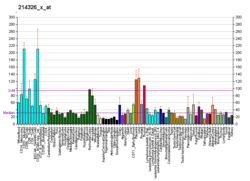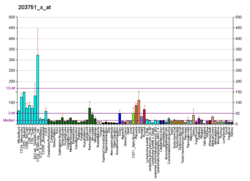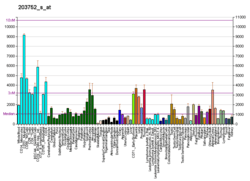JunD
Transcription factor JunD is a protein that in humans is encoded by the JUND gene.[4][5]
Function
The protein encoded by this intronless gene is a member of the JUN family, and a functional component of the AP1 transcription factor complex. It has been proposed to protect cells from p53-dependent senescence and apoptosis. Alternate translation initiation site usage results in the production of different isoforms.[6]
ΔJunD
The dominant negative mutant variant of JunD, known as ΔJunD or Delta JunD, is a potent antagonist of the ΔFosB transcript, as well as other forms of AP-1-mediated transcriptional activity.[7][8][9] In the nucleus accumbens, ΔJunD directly opposes many of the neurological changes that occur in addiction (i.e., those induced by ΔFosB).[8][9] ΔFosB inhibitors (drugs that oppose its action) may be an effective treatment for addiction and addictive disorders.[10]
Interactions
JunD has been shown to interact with ATF3,[11] MEN1,[12] DNA damage-inducible transcript 3[13] and BRCA1.[14]
See also
References
- 1 2 3 GRCh38: Ensembl release 89: ENSG00000130522 - Ensembl, May 2017
- ↑ "Human PubMed Reference:".
- ↑ "Mouse PubMed Reference:".
- ↑ Nomura N, Ide M, Sasamoto S, Matsui M, Date T, Ishizaki R (July 1990). "Isolation of human cDNA clones of jun-related genes, jun-B and jun-D". Nucleic Acids Res. 18 (10): 3047–8. doi:10.1093/nar/18.10.3047. PMC 330838. PMID 2112242.
- ↑ Berger I, Shaul Y (June 1991). "Structure and function of human jun-D". Oncogene. 6 (4): 561–6. PMID 1903194.
- ↑ "Entrez Gene: JUND jun D proto-oncogene".
- ↑ Hyman SE, Malenka RC, Nestler EJ (2006). "Neural mechanisms of addiction: the role of reward-related learning and memory". Annu. Rev. Neurosci. 29: 565–98. doi:10.1146/annurev.neuro.29.051605.113009. PMID 16776597.
- 1 2 Robison AJ, Nestler EJ (November 2011). "Transcriptional and epigenetic mechanisms of addiction". Nat. Rev. Neurosci. 12 (11): 623–37. doi:10.1038/nrn3111. PMC 3272277. PMID 21989194.
ΔFosB has been linked directly to several addiction-related behaviors ... Importantly, genetic or viral overexpression of ΔJunD, a dominant negative mutant of JunD which antagonizes ΔFosB- and other AP-1-mediated transcriptional activity, in the NAc or OFC blocks these key effects of drug exposure14,22–24. This indicates that ΔFosB is both necessary and sufficient for many of the changes wrought in the brain by chronic drug exposure. ΔFosB is also induced in D1-type NAc MSNs by chronic consumption of several natural rewards, including sucrose, high fat food, sex, wheel running, where it promotes that consumption14,26–30. This implicates ΔFosB in the regulation of natural rewards under normal conditions and perhaps during pathological addictive-like states.
- 1 2 Pitchers KK, Frohmader KS, Vialou V, Mouzon E, Nestler EJ, Lehman MN, Coolen LM (October 2010). "ΔFosB in the nucleus accumbens is critical for reinforcing effects of sexual reward". Genes Brain Behav. 9 (7): 831–40. doi:10.1111/j.1601-183X.2010.00621.x. PMC 2970635. PMID 20618447.
- ↑ Malenka RC, Nestler EJ, Hyman SE (2009). "Chapter 15: Reinforcement and addictive disorders". In Sydor A, Brown RY. Molecular Neuropharmacology: A Foundation for Clinical Neuroscience (2nd ed.). New York: McGraw-Hill Medical. pp. 384–385. ISBN 9780071481274.
- ↑ Chu HM, Tan Y, Kobierski LA, Balsam LB, Comb MJ (January 1994). "Activating transcription factor-3 stimulates 3',5'-cyclic adenosine monophosphate-dependent gene expression". Mol. Endocrinol. 8 (1): 59–68. doi:10.1210/mend.8.1.8152431. PMID 8152431.
- ↑ Agarwal SK, Guru SC, Heppner C, Erdos MR, Collins RM, Park SY, Saggar S, Chandrasekharappa SC, Collins FS, Spiegel AM, Marx SJ, Burns AL (January 1999). "Menin interacts with the AP1 transcription factor JunD and represses JunD-activated transcription". Cell. 96 (1): 143–52. doi:10.1016/S0092-8674(00)80967-8. PMID 9989505.
- ↑ Ubeda M, Vallejo M, Habener JF (November 1999). "CHOP enhancement of gene transcription by interactions with Jun/Fos AP-1 complex proteins". Mol. Cell. Biol. 19 (11): 7589–99. PMC 84780. PMID 10523647.
- ↑ Hu YF, Li R (June 2002). "JunB potentiates function of BRCA1 activation domain 1 (AD1) through a coiled-coil-mediated interaction". Genes Dev. 16 (12): 1509–17. doi:10.1101/gad.995502. PMC 186344. PMID 12080089.
Further reading
- Mollinedo F, Vaquerizo MJ, Naranjo JR (1991). "Expression of c-jun, jun B and jun D proto-oncogenes in human peripheral-blood granulocytes". Biochem. J. 273(Pt 2): 477–9. PMC 1149869. PMID 1899335.
- Franklin CC, McCulloch AV, Kraft AS (1995). "In vitro association between the Jun protein family and the general transcription factors, TBP and TFIIB". Biochem. J. 305 (3): 967–74. doi:10.1042/bj3050967. PMC 1136352. PMID 7848298.
- Maruyama K, Sugano S (1994). "Oligo-capping: a simple method to replace the cap structure of eukaryotic mRNAs with oligoribonucleotides". Gene. 138 (1–2): 171–4. doi:10.1016/0378-1119(94)90802-8. PMID 8125298.
- Chu HM, Tan Y, Kobierski LA, Balsam LB, Comb MJ (1994). "Activating transcription factor-3 stimulates 3',5'-cyclic adenosine monophosphate-dependent gene expression". Mol. Endocrinol. 8 (1): 59–68. doi:10.1210/mend.8.1.8152431. PMID 8152431.
- Trask B, Fertitta A, Christensen M, Youngblom J, Bergmann A, Copeland A, de Jong P, Mohrenweiser H, Olsen A, Carrano A (1993). "Fluorescence in situ hybridization mapping of human chromosome 19: cytogenetic band location of 540 cosmids and 70 genes or DNA markers". Genomics. 15 (1): 133–45. doi:10.1006/geno.1993.1021. PMID 8432525.
- Dorsey MJ, Tae HJ, Sollenberger KG, Mascarenhas NT, Johansen LM, Taparowsky EJ (1995). "B-ATF: a novel human bZIP protein that associates with members of the AP-1 transcription factor family". Oncogene. 11 (11): 2255–65. PMID 8570175.
- Claret FX, Hibi M, Dhut S, Toda T, Karin M (1996). "A new group of conserved coactivators that increase the specificity of AP-1 transcription factors". Nature. 383 (6599): 453–7. doi:10.1038/383453a0. PMID 8837781.
- Kallunki T, Deng T, Hibi M, Karin M (1996). "c-Jun can recruit JNK to phosphorylate dimerization partners via specific docking interactions". Cell. 87 (5): 929–39. doi:10.1016/S0092-8674(00)81999-6. PMID 8945519.
- Aronheim A, Zandi E, Hennemann H, Elledge SJ, Karin M (1997). "Isolation of an AP-1 repressor by a novel method for detecting protein-protein interactions". Mol. Cell. Biol. 17 (6): 3094–102. doi:10.1128/mcb.17.6.3094. PMC 232162. PMID 9154808.
- Suzuki Y, Yoshitomo-Nakagawa K, Maruyama K, Suyama A, Sugano S (1997). "Construction and characterization of a full length-enriched and a 5'-end-enriched cDNA library". Gene. 200 (1–2): 149–56. doi:10.1016/S0378-1119(97)00411-3. PMID 9373149.
- Labudova O, Krapfenbauer K, Moenkemann H, Rink H, Kitzmüller E, Cairns N, Lubec G (1998). "Decreased transcription factor junD in brains of patients with Down syndrome". Neurosci. Lett. 252 (3): 159–62. doi:10.1016/S0304-3940(98)00569-2. PMID 9739985.
- Venugopal R, Jaiswal AK (1998). "Nrf2 and Nrf1 in association with Jun proteins regulate antioxidant response element-mediated expression and coordinated induction of genes encoding detoxifying enzymes". Oncogene. 17 (24): 3145–56. doi:10.1038/sj.onc.1202237. PMID 9872330.
- Agarwal SK, Guru SC, Heppner C, Erdos MR, Collins RM, Park SY, Saggar S, Chandrasekharappa SC, Collins FS, Spiegel AM, Marx SJ, Burns AL (1999). "Menin interacts with the AP1 transcription factor JunD and represses JunD-activated transcription". Cell. 96 (1): 143–52. doi:10.1016/S0092-8674(00)80967-8. PMID 9989505.
- Liberati NT, Datto MB, Frederick JP, Shen X, Wong C, Rougier-Chapman EM, Wang XF (1999). "Smads bind directly to the Jun family of AP-1 transcription factors". Proc. Natl. Acad. Sci. U.S.A. 96 (9): 4844–9. doi:10.1073/pnas.96.9.4844. PMC 21779. PMID 10220381.
- Gobl AE, Berg M, Lopez-Egido JR, Oberg K, Skogseid B, Westin G (1999). "Menin represses JunD-activated transcription by a histone deacetylase-dependent mechanism". Biochim. Biophys. Acta. 1447 (1): 51–6. doi:10.1016/S0167-4781(99)00132-3. PMID 10500243.
- Ubeda M, Vallejo M, Habener JF (1999). "CHOP enhancement of gene transcription by interactions with Jun/Fos AP-1 complex proteins". Mol. Cell. Biol. 19 (11): 7589–99. PMC 84780. PMID 10523647.
- Miyamoto NG, Medberry PS, Hesselgesser J, Boehlk S, Nelson PJ, Krensky AM, Perez HD (2000). "Interleukin-1beta induction of the chemokine RANTES promoter in the human astrocytoma line CH235 requires both constitutive and inducible transcription factors". J. Neuroimmunol. 105 (1): 78–90. doi:10.1016/S0165-5728(00)00195-8. PMID 10713367.
- Sharma SC, Richards JS (2000). "Regulation of AP1 (Jun/Fos) factor expression and activation in ovarian granulosa cells. Relation of JunD and Fra2 to terminal differentiation". J. Biol. Chem. 275 (43): 33718–28. doi:10.1074/jbc.M003555200. PMID 10934195.
External links
- JUND+protein,+human at the US National Library of Medicine Medical Subject Headings (MeSH)
- FactorBook JunD
This article incorporates text from the United States National Library of Medicine, which is in the public domain.




